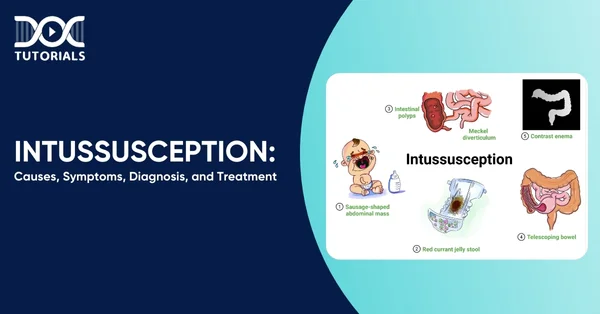Intussusception | Causes, Symptoms, Diagnosis, and Treatment

Intussusception stands as the leading cause of intestinal obstruction in children under the age of three. While the exact cause remains unclear in the majority of paediatric cases, it often develops without an identifiable trigger. On the contrary, intussusception is rarely seen in adults.
Knowing the causes and clinical approach to intussusception is essential for NEET PG aspirants preparing for questions in paediatrics and general surgery. Keep reading for a detailed insight into intussusception.
What is Intussusception?
Intussusception is a severe and critical health problem whereby a section or piece of the intestine enters another section, and this causes an obstruction. This action is often compared to the collapse of a telescope. It most commonly involves the small intestine.
If left untreated, the obstruction can restrict blood supply to the affected area and hinder the movement of food through the digestive tract. This may result in swelling, inflammation, and potentially life-threatening complications.
What are the Causes of Intussusception?
The following are the causes of intussusception:
- Lifestyle and Dietary Influences
Dietary habits can impact the risk of intussusception in children. A diet lacking in fibre may result in constipation, which can elevate the chances of intestinal obstruction. Additionally, some foods that irritate the digestive system may be contributing factors.
- Infectious and Environmental Factors
Although the precise cause of intussusception is not always identified, viral infections have been linked to its development. For example, rotavirus usually infects children and can be the cause of lymphoid tissue bulging inside the intestines, which leads to this condition. Environmental exposures to specific pathogens may also contribute to its onset.
- Genetic and Autoimmune Factors
While genetic involvement is not strongly established, certain inherited disorders, such as familial adenomatous polyposis, are known to raise the risk of intestinal blockages, including intussusception. Autoimmune diseases that trigger inflammation in the gastrointestinal tract may also play a role in increasing susceptibility.
What are the Risk Factors of Intussusception?
Several factors contribute to the likelihood of developing intussusception. These are as follows:
- Sex
Males are affected more frequently than females.
- Age
This condition is considerably more common in children, particularly between 6 months and 3 years of age. In this age group, it is recognised as the leading cause of intestinal obstruction.
- Congenital Abnormalities of the Intestine
Atypical development of the intestine, such as malrotation, where the bowel fails to form or rotate properly during foetal growth, is linked to a heightened risk of intussusception.
- Underlying Medical Conditions
Certain disorders are associated with an increased risk of complications. These include:
- Henoch-Schönlein purpura (IgA vasculitis)
- Cystic fibrosis
- Coeliac disease
- Crohn’s disease
What are the Symptoms of Intussusception?
Abdominal pain and signs of bowel obstruction are the most frequently observed symptoms in intussusception. However, a range of other symptoms may also be present, such as:
- Symptoms in Children
Intussusception may be hard to diagnose in children, especially smaller children who lack the ability to clearly communicate their discomfort. The condition is frequently displayed as intermittent cramp-like abdominal pain. Other symptoms, such as nausea and vomiting, can be seen.
Furthermore, during the intervals between painful episodes, the symptoms may seem to subside temporarily, with the child appearing well enough to engage in normal activities. In cases where the condition leads to restricted blood supply to the affected section of the intestine, the pain may become persistent.
Additional signs in children may include:
- High body temperature
- Presence of blood in the stool
- Fatigue or low energy levels
- A noticeable or palpable lump in the abdomen
- Vomiting and nausea
- Diarrhoea
- Symptoms in Adults
Intussusception is not common among adults and can cause diagnostic challenges because the condition is not widely recognised, and symptoms are not specific. In cases where the symptoms are observed, they are usually abdominal discomfort accompanied by nausea and vomiting.
These manifestations tend to be acute and may appear intermittently. As a result, the concerned individuals can postpone the medical assessment by a few weeks.
How to Diagnose Intussusception?
The healthcare professional will begin by taking a detailed account of the symptoms. During the physical examination, a sausage-shaped mass may be detected in the abdomen. To confirm the diagnosis, further investigations may be requested as follows:
- Ultrasound
If the physical examination results are inconclusive, an ultrasound may be performed. It typically shows dilated small bowel loops and the characteristic ‘target sign’ (intraluminal haematoma). It also aids in identifying any associated abdominal abnormalities.
- Abdominal Examination
A clinical assessment of the abdomen may detect signs such as a sausage-shaped mass, localised tenderness, or a sensation of fluctuance indicating air movement.
- Computed Tomography (CT)
It is carried out because it provides a very detailed image which can be used in proper diagnosis as well as subsequent analysis.
- X-ray
Radiographs can reveal an abnormal gas pattern caused by distended loops of the small intestine. The ‘target sign’, which is suggestive of intussusception, appears in over 85% of cases.
- Barium Enema
A barium solution is introduced into the rectum to outline the intestines. This assists in the identification of the obstructions due to intussusception, and also the size and exact location.
- Colonoscopy
This treatment involves putting a flexible tube with a camera through the rectum to examine the lining of the intestines and look for any evidence of intussusception..
What are the Treatment Options for Intussusception?
Hospital admission is often required for the intussusception treatment. Initial care may involve:
- Fluid replacement therapy to correct dehydration and restore electrolyte balance.
- Nasogastric decompression using a tube to relieve pressure in the stomach.
In certain instances, non-surgical methods such as air contrast enema or ultrasound-guided hydrostatic reduction may be employed. These techniques can sometimes successfully resolve the condition without the need for surgery.
If conservative measures fail or if there is evidence of bowel tissue death, surgery may be indicated. The procedure usually involves:
- Manual reduction of the intussusception by repositioning the involved segment of the bowel.
- Surgical resection to remove any sections of the intestine that are damaged or non-viable.
FAQs About Intussusception
- What are the primary signs of intussusception?
Key symptoms of intussusception include intense abdominal pain, vomiting, the presence of blood in the stool, and swelling of the abdomen. In paediatric cases, signs such as drowsiness and increased irritability may also be observed.
- How is intussusception identified?
The diagnosis of intussusception is done by reviewing the patient’s symptoms, performing clinical examination, and tests like ultrasound or CT scans to confirm the condition.
- Is intussusception possible in adults?
Yes, intussusception is possible to develop in adults. When it does happen, it is often linked to underlying medical issues such as tumours or previous abdominal surgeries.
- Can intussusception resolve without surgery?
Yes, in some cases, non-surgical methods like air contrast enema can effectively treat the condition.
- What clinical findings suggest intussusception on examination?
A palpable sausage-shaped abdominal mass, tenderness, and signs of bowel obstruction are key physical findings.
Conclusion
Intussusception is a serious gastrointestinal condition that needs immediate medical attention to prevent complications. Early identification of symptoms, accurate diagnosis, and on-time treatment are essential for managing effectively. Whether through non-surgical reduction or surgical intervention, appropriate care improves outcomes significantly.
For reliable resources, expert guidance, and structured learning on medical topics like intussusception, DocTutorials is a platform that gives valuable support to NEET PG aspirants.
Explore the NEET PG course by DocTutorials and excel in your medical studies.
Latest Blogs
-

NEET SS Exam 2024: Analysis, Key Dates, Counselling
The NEET SS 2024 exam kicked off on March 29, 2025. Over two days and two slots, candidates across 13…
-

NEET PG Registration 2025: An Essential Guide For Exam Prep
The NEET PG registration, which is conducted online, is a crucial step in the exam process. Filling out the NEET…
-

NEET PG Syllabus 2026: A Must-Have Complete Guide for Exam Success
The NEET PG Syllabus acts as one of the foundation stones for aspiring postgraduate medical students like you who are…




